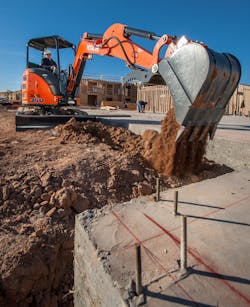Sometimes you get more good information than a few pages of print can hold.
That was certainly the case for Construction Equipment’s Buying File on mini excavators under 6 metric tons.
With around 17 manufacturers of minis, a category that’s exploded in popularity over the last decade, there was no shortage of opinions on the question “What’s the single most important consideration for an equipment manager planning a mini excavator purchase?”
The answers serve as a great refresher on the basic blocking and tackling that should be done before almost any buy. Here are a few.
“First, you should determine the size of machine you need,” says Keith Rohrbacker, product manager at Kubota. “This includes digging depth, dump height, lifting capacity, overall weight, and whether zero tail swing or conventional tail swing fits your application needs. Also consider functionality, comfort, responsiveness, visibility, and ease in performing routine maintenance.
“Consider the reliability and durability of the brand of machine you are purchasing. The dealer should be an authorized compact excavator dealer and be able to fulfill all of your service and parts needs in a timely manner,” Rohrbacker says.
This advice, and some words on utilization, came from Jamie Wright at Terex: “When choosing a machine, make sure the piece of equipment is going to be adequate for 85 to 90 percent of your job sites’ needs—don’t sacrifice power, breakout force or anything else just to save a dollar. Also, always buy quality; a compact excavator needs to be durable and reliable because downtime is expensive.
“Productivity features are also important in building a case for investment to meet on-site productivity requirements and project time constraints,” Wright says. “ROI will be considered in the context of the hours the machine is working and revenue generated, so whether a customer ‘bites the bullet’ during tough economic times ultimately depends on the financial situation of the company and the anticipated level of current and future projects.”
Nathan Ryan, Mustang’s compact excavator product manager, provides a solid summation. “Compact excavators are available in a vast array of sizes and configurations,” he says. “Zero tail swing models offer the best versatility at a minimal sacrifice of performance, while operating weight will dictate the equipment required to transport the excavator. Once a configuration has been selected and a size range has been narrowed down, focus on key specifications. Finally, maximize ROI by purchasing attachments that increase the equipment’s productivity.”
You can get more advice—plus market trends, fresh analysis, and cost-of-ownership data—in the July Buying File.






